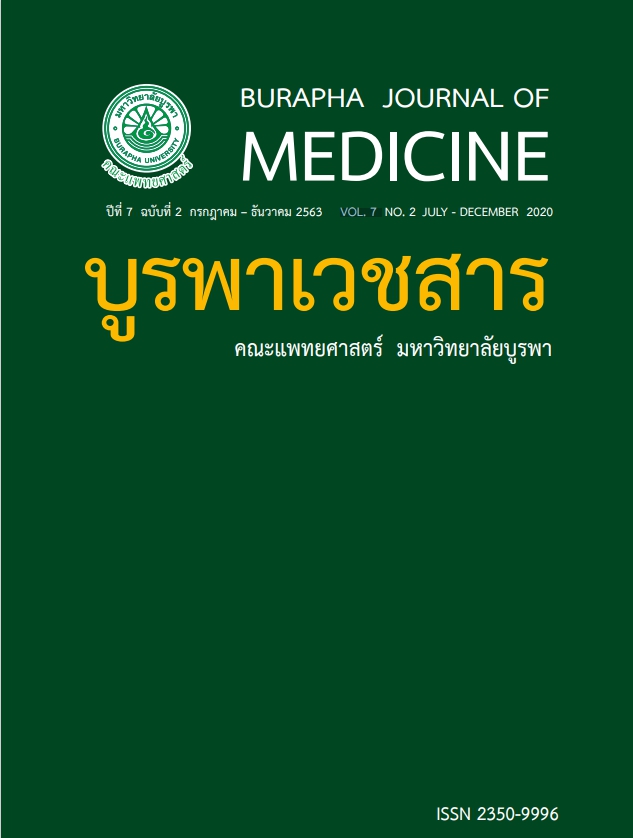ความเที่ยงและความน่าเชื่อถือของเตียงรับแรงกด
คำสำคัญ:
ตาชั่งมาตรฐาน, เตียงรับแรงกด, หัตถการ, การจัด, ดัด, ดึงบทคัดย่อ
บทนำ หัตถบำบัดเป็นการรักษาทางกายภาพบำบัดที่นิยมใช้แพร่หลาย การเรียนรู้โดยเฉพาะภาคปฏิบัติจัดเป็น
มาตรฐานหลักสูตรของวิชาชีพกายภาพบำบัด ซึ่งยังไม่สามารถประเมินความแม่นยำปริมาณแรงของปริมาณแรง
กดได้ชัดเจน
วัตถุประสงค์ เพื่อหาความเที่ยงตรง และความน่าเชื่อถือของเตียงรักษาทางหัตถการ ที่มีแผ่นรับและรายงาน
แรงกด
วิธีการศึกษา วางวัตถุหนัก 1, 2, 3, 4 และ 5 กิโลกรัม ลงบนเครื่องชั่งน้ำหนักที่มีมาตรฐาน หลังจากนั้นวางลง
บนเตียงที่มีแผ่นรับแรงกด วางนิ่ง 5 วินาที และยกขึ้น 5 วินาที ทำซ้ำ 3 ครั้ง
ผลการศึกษา ตาชั่งมาตรฐานและเตียงรับแรงกดสามารถรายงานผลได้อย่างน่าเชื่อถือ สามารถทำหน้าที่รับแรง
กดได้อย่างเที่ยงตรงและน่าเชื่อถือ (Cronbach’s Alpha = 0.857)
สรุป เตียงรับแรงกดสามารถส่งเสริมการเรียนรู้และการฝึกภาคทฤษฎีและโดยเฉพาะภาคปฏิบัติที่ต้องมีการ
ประเมินแรงกดที่กระทำต่อโครงสร้างผู้ป่วย ทำให้สามารถประเมินผลได้ทันทีว่าสามารถส่งแรงในปริมาณที่
เหมาะสม การศึกษาครั้งนี้พบว่าเตียงรับแรงกดสามารถรายงานผลได้อย่างเที่ยงตรงและน่าเชื่อถือ สามารถนำ
มาประยุกต์ใช้ประกอบการเรียนการสอนได้
เอกสารอ้างอิง
LM. Efficacy of spinal manipulation and
mobilization for low back pain and neck
pain: a systematic review and best evidence
synthesis. Spine J. 2004; 4: 335–56.
2. Boissonnault W, Bryan JM, Fox KJ. Joint
manipulation curricula in physical therapist
professional degree programs. J Orthop
Sports Phys Ther. 2004; 34: 171–81.
3. Flynn TW, Wainner RS, Fritz JM. Spinal
manipulation in physical therapist
professional degree education: a model
for teaching and integration into clinical
practice. J Orthop Sports Phys Ther. 2006;
36: 577–87.
4. Crosbie J, Gass E, Jull G, Morris M, Rivett D,
Ruston S, et al. Sustainable undergraduate
education and professional compentency.
Aust J Physiother. 2002; 48: 5–7.
5. Magarey ME, Rebbeck T, Coughlan B,
Grimmer K, Rivett DA, Refshauge K. Premanipulative testing of the cervical spine:
review, revision and new clinical guidelines.
Man Ther. 2004; 9: 95–108.
6. Maitland GD, Banks K, English K, Hengeveld
E. Maitland’s vertebral manipulation.
(7th ed) Oxford: Butterworth-Heinemann;
2005.
7. Grieve GP. Mobilisation of the spine. (5th
ed)
Edinburgh: Churchill Livingstone; 1991.
8. Snodgrass S, Rivett D, Robertson V,
Stojanovski E. Cervical spine mobilisation
forces applied by physiotherapy students.
Physiotherapy. 2010; 96: 120–9.
9. Smith E, Conradie M,Wessels J,Witbooi I,
Otto R . Measurement of the magnitude of
force applied by students when learning a
mobilization technique. S Afr J Physiother.
2003; 59: 3–8.
10. Langshaw M. Cervical spine mobilisation:
the effect of experience and subject on
dose. Undergraduate honours thesis.
Sydney: University of Sydney; 2001..



